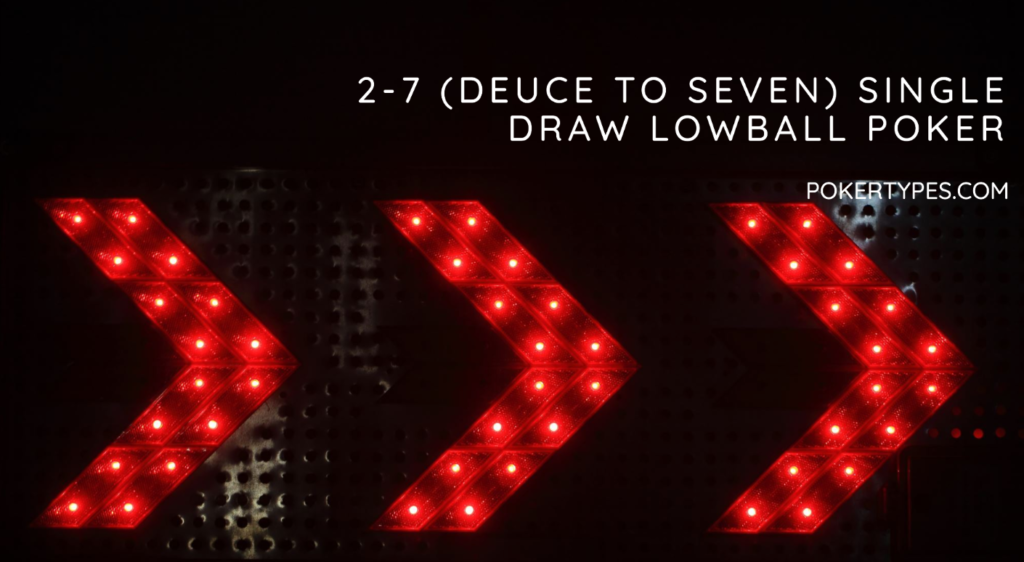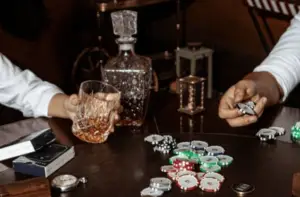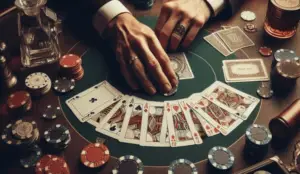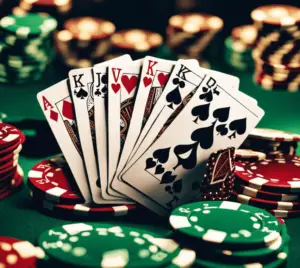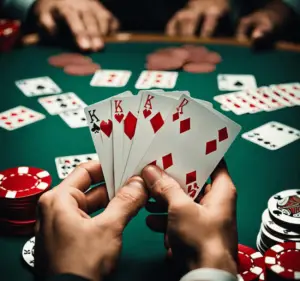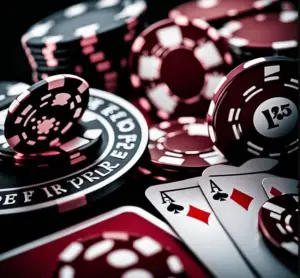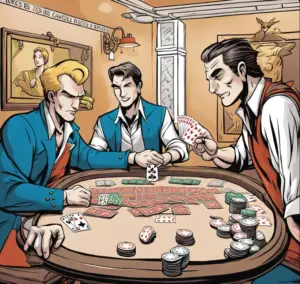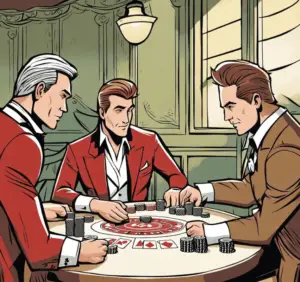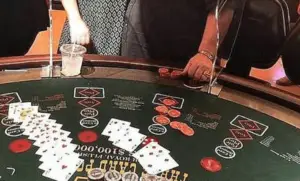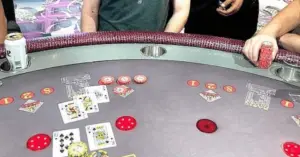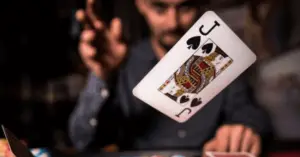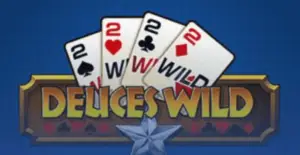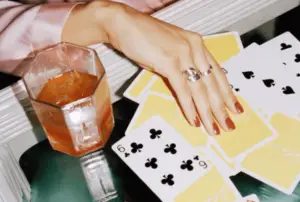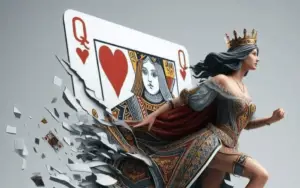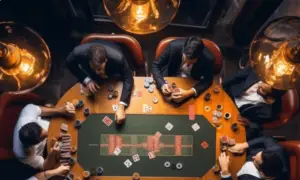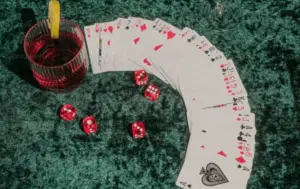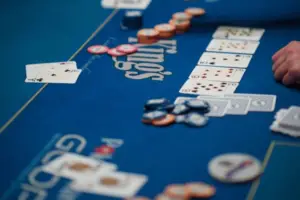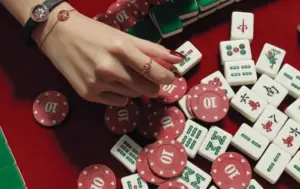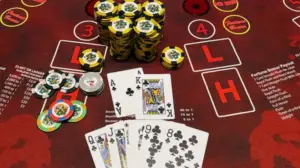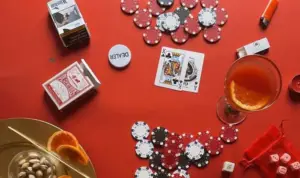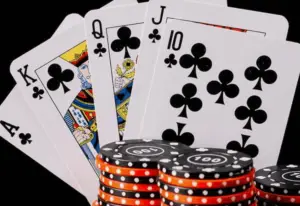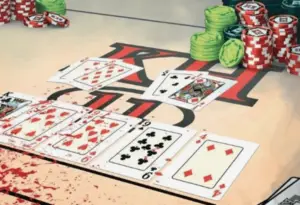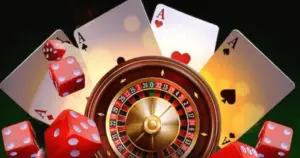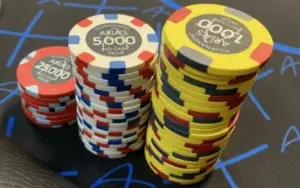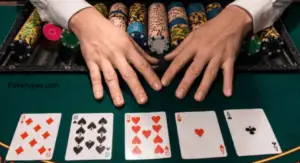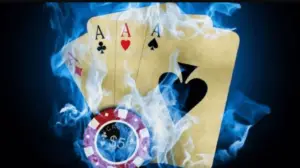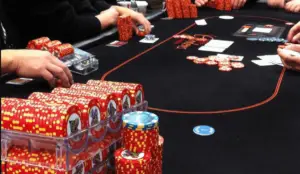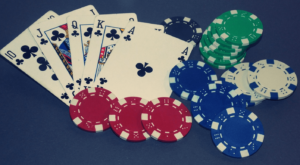2-7 Single Draw Lowball Poker is a type of lowball draw poker that reverses the traditional hand ranking. In this game, players aim for the lowest possible hand, with 7-5-4-3-2 being the best.
It’s also known as Kansas City Lowball or Deuce-to-Seven Single Draw. The game originated in the Midwest United States and gained popularity in high-stakes cash games and mixed game formats.
Unlike regular poker, straights and flushes count against you, and aces are always high. Players get one chance to draw new cards, adding a strategic element.
This variant is featured in the World Series of Poker and is a favorite among poker pros like Doyle Brunson and Phil Ivey.
Its no-limit betting structure makes for exciting and potentially costly gameplay, attracting both skilled players and thrill-seekers to the felt.
Rules and Gameplay of Deuce-to-Seven Single Draw
Objective: Making the lowest possible hand
In 2-7 Single Draw Lowball, your goal is to make the worst hand possible. It’s like playing poker backward! Instead of trying to get a royal flush, you want the lowest cards you can find.
This game is a real head-scratcher for folks used to regular poker. The name “2-7” comes from the best possible hand you can get: 7-5-4-3-2.
Yep, that’s right – a seven is your highest card in the best hand. It’s like golf – the lower your score, the better you’re doing.
Hand rankings in Deuce-to-Seven Single Draw
1. Best hand: 7-5-4-3-2 (unsuited)
The top dog in 2-7 Single Draw is 7-5-4-3-2, with no two cards of the same suit. This hand is called the“wheel” or“Number One”. It’s the poker equivalent of a hole-in-one! Here’s a quick rundown of the top five hands:
7-5-4-3-2 (Number One)
7-6-4-3-2 (Number Two)
7-6-5-3-2 (Number Three)
7-6-5-4-2 (Number Four)
8-5-4-3-2 (Eight-perfect)
2. Straights and flushes count against players
Here’s where things get tricky. In 2-7 Single Draw, straights and flushes are bad news. They actually count against you! So if you’ve got 6-5-4-3-2, that’s not a good hand – it’s a straight, which is worse than having high cards.
The same goes for flushes. If all your cards are the same suit, that’s a big no-no. It’s like accidentally scoring a goal in your own net in soccer.
3. Aces always high
In this game, aces are always high. They’re like the tallest kid in class – they can’t hide! This means A-2-3-4-5 isn’t a good hand at all. In fact, it’s pretty terrible. The ace makes it much worse than a hand like 9-8-7-6-4.
Betting structure
1. Blinds and button
2-7 Single Draw uses the same blind and button system as Texas Hold’em. There’s a small blind, a big blind, and a dealer button that moves clockwise after each hand. This keeps the game fair and makes sure everyone takes turns being in different positions.
The player to the left of the big blind starts the action. They can call, raise, or fold. It’s like being the first kid picked for dodgeball – you set the tone for the game!
2. No-limit format
Most 2-7 Single Draw games are played in a no-limit format. This means you can bet all your chips at any time. It’s like pushing all your chips to the middle of the table and saying,
“I’m all in!”This no-limit style makes the game super exciting.
You never know when someone might go all-in. It’s like a game of chicken – who’s gonna blink first?
Gameplay sequence
1. Initial deal
The game kicks off with each player getting five cards face down. It’s like getting a secret message – only you know what’s in your hand!
2. First betting round
After everyone’s got their cards, the first betting round begins. Starting with the player left of the big blind, each person can:
Fold: Drop out of the hand (like saying “I’m out!”)
Call: Match the current bet
Raise: Increase the bet
This round is all about sizing up your opponents. Are they betting big? Looking nervous? It’s like being a detective, trying to figure out what everyone’s got.
3. Drawing phase
Here’s where 2-7 Single Draw gets its name. After the first betting round, players can exchange cards in their hands. You can swap out any number of cards, from zero (called “standing pat”) to all five.
This is your chance to improve your hand. Got a pair? Ditch one of those cards! High card giving you trouble? Swap it out! It’s like trading baseball cards, but way more intense.
4. Second betting round
After everyone’s done drawing, there’s another betting round. This time, the first active player left of the button starts things off. The betting works just like the first round.
This is where the real action happens. Players who improved their hands might bet big. Others might try to bluff their way to victory. It’s like a high-stakes game of chicken!
5. Showdown
If there’s more than one player left after the second betting round, it’s time for the showdown. Everyone still in the hand reveals their cards.
The player with the lowest hand wins the pot. Remember, 7-5-4-3-2 is the best possible hand. So if you’ve got that, you’re sitting pretty! But even a hand like 9-8-7-6-4 can win if everyone else has pairs or higher cards.
Strategy and Tactics
1. Starting hand selection
In 2-7 Single Draw, picking the right starting hands is super important. You want to look for cards that give you a shot at making the lowest possible hand. The best hand you can get is 7-5-4-3-2, so any cards that can help you make that are golden.
Pro tip: Always keep an eye out for deuces(2s). They’re like gold in this game! A hand with a deuce is usually worth playing, especially if you’ve got other low cards to go with it. Remember, aces are bad in this game.
They’re always high, so having an ace in your hand is like starting with a handicap. Avoid playing hands with aces unless you’re feeling really lucky or tricky. Good starting hands might look like:
2-3-4-7-X (where X is any card 8 or lower)
2-3-5-6-X
2-4-5-6-X
These hands give you a good shot at making a strong low hand after the draw.
2. Drawing strategy
a. Standing pat vs. drawing cards
Sometimes, you’ll get dealt a hand that’s already pretty good. When this happens, you might choose to “stand pat” – that means not drawing any new cards. It’s like telling your opponents, “I’m happy with what I’ve got!”Standing pat can be a powerful move.
It makes your opponents think you’ve got a really strong hand. But be careful! If you stand pat with a so-so hand, you might get caught bluffing.
B. Number of cards to draw
When you do decide to draw, you’ve got to choose how many cards to swap out. This is a big decision!
Drawing one card: This is usually best when you’ve got four good low cards and just need one more to complete your hand. For example, if you’ve got 2-3-4-7-Q, you’d probably want to ditch that Queen and hope for a 5 or 6.
Drawing two cards: This is riskier, but sometimes necessary. You might do this if you’ve got three solid low cards and need two more to make a good hand.
Drawing three or more: This is pretty rare in high-level play. It’s usually a sign of a weak starting hand. But sometimes, if the pot’s big enough, it might be worth taking a shot.
Remember, the more cards you draw, the harder it is to make a good hand. Phil Ivey, a poker superstar, once said, “In 2-7, if you’re drawing more than one, you’re usually drawing dead.”
3. Betting strategies
a. Aggression and position
In 2-7 Single Draw, being aggressive can really pay off. If you’ve got a good hand, don’t be afraid to bet big! This puts pressure on your opponents and can make them fold better hands.
Position is super important too. Being last to act (on the “button“) gives you a big advantage. You get to see what everyone else does before you make your move. Use this info to your advantage!
b. Bluffing in no-limit format
Bluffing is a big part of 2-7 Single Draw, especially in no-limit games. Since there’s only one draw, it’s hard for your opponents to know exactly what you’ve got. This makes bluffing extra effective.
A common bluff is to stand pat (not draw any cards) even when you don’t have a great hand. This makes your opponents think you’ve got a monster, and they might fold even if they’ve got better cards than you!
But be careful! Good players will catch on if you bluff too much. Mix up your play to keep them guessing.
4. Reading opponents and tells
Reading your opponents is crucial in 2-7 Single Draw. Here are some things to watch for:
How many cards they draw
How quickly they act
How much they bet
Their body language
For example, if a player draws one card and then bets big, they might have made a strong hand. But if they draw one and then check, they might have missed their draw. Daniel Negreanu, another poker legend, is famous for his ability to read opponents. He once said, “In 2-7, I’m not playing my cards.
I’m playing my opponent.” Remember, every player has “tells” – little habits that give away the strength of their hand.
Some might fidget when they’re bluffing, others might freeze up when they’ve got a great hand. Pay attention and you’ll start to spot these tells!
Advanced Concepts and Tips
Importance of blockers
In 2-7 Single Draw, blockers are super important. They’re like secret weapons that can help you make better decisions.
A blocker is a card you have that your opponent might want. For example, if you’ve got a 2 in your hand, that means there’s one less 2 out there for your opponents to get.
Phil Galfond, a poker pro, says blockers can be game-changers. If you’ve got the Kd (King of diamonds), it’s harder for your opponent to have a diamond flush.
This might make you more likely to call a big bet on a diamond-heavy board. But don’t go overboard! Daniel Negreanu warns that some players put too much weight on blockers. They’re just one piece of the puzzle, not the whole picture.
Adjusting strategy based on table dynamics
Table dynamics in 2-7 Single Draw can change faster than a New York minute. You’ve got to be ready to switch gears at any time.
If the table’s playing tight (like everyone’s scared of their own shadow), you might want to open up your range and steal more pots. But if it’s a wild game with lots of action, tighten up and wait for premium hands.
Jason Mercier, who’s won the WSOP 2-7 Single Draw event twice, says reading the table is key. If you notice a player always drawing one card, they might be bluffing a lot. Use that info to your advantage!
Bankroll management for no-limit games
In no-limit 2-7 Single Draw, your whole stack can disappear faster than free pizza at a college dorm. That’s why good bankroll management is crucial. A common rule is to have at least 20 buy-ins for your regular game.
So if you’re playing $1/$2 with a $200 max buy-in, you should have at least $4,000 set aside for poker. Billy Baxter, the king of 2-7 Single Draw with five WSOP bracelets, says to never play with scared money.
If you’re worried about losing, you won’t play your best game. Remember, poker’s a long game. You might lose 10 buy-ins in a row (ouch!), but if you’re a good player and manage your bankroll well, you’ll come out on top in the long run.
2-7 Single Draw in Competitive Play
History of 2-7 Single Draw at WSOP
2-7 Single Draw has been a big deal at the World Series of Poker for a long time. It’s like the cool kid at school that everyone wants to hang out with. The game first showed up at the WSOP way back in 1973. That’s older than most of the players! At first, it was a $3,000 buy-in event.
But the WSOP folks kept changing things up. They made it a $5,000 buy-in from 1974 to 1976. Then, they really cranked it up to $10,000 from 1977 to 1985.
It was like the game got a promotion! In 2009, they brought back the $10,000 Championship event. It’s been a fan favorite ever since. It’s like the Super Bowl of 2-7 Single Draw!
Notable champions and prize pools
Some real poker superstars have won this event. It’s like a who’s who of poker legends. Here are some big names:
Billy Baxter: This guy is the king of 2-7 Single Draw. He’s won it five times! That’s like winning the lottery five times in a row.
Nick Schulman: He’s won it twice, in 2009 and 2012. He’s like the new kid on the block showing the old-timers how it’s done.
Jason Mercier: He won in 2016 and 2023. Talk about a comeback!
The prize pools are no joke either. In 2023, the $1,500 event had a whopping 548 players and a prize pool of $731,580. The winner, Jason Mercier, took home $151,276. That’s a lot of pizza money!
High-stakes cash games and mixed game formats
2-7 Single Draw isn’t just for tournaments. It’s a big hit in high-stakes cash games too. In places like Bobby’s Room at the Bellagio, you might see pros playing for thousands of dollars per hand. It’s like watching a high-stakes poker movie in real life!
The game is also popular in mixed game formats. That’s where players switch between different poker games. 2-7 Single Draw is often part of games like H.O.R.S.E. and the Poker Players Championship. It’s like the poker version of a decathlon!
Online poker platforms offering 2-7 Single Draw
You don’t have to go to Las Vegas to play 2-7 Single Draw. Many online poker sites offer the game too. It’s like having a mini-WSOP in your living room! Sites like PokerStars and WSOP.com have 2-7 Single Draw games.
You can play for real money or just for fun. Some sites even have special tournaments for the game. But remember, online poker isn’t legal everywhere in the U.S. It’s like a patchwork quilt of laws. Make sure it’s okay in your state before you play!
2-7 Single Draw might not be as famous as Texas Hold’em, but it’s got a special place in the poker world. From the glitz of the WSOP to online games, it’s a game that keeps players coming back for more.
Comparison to Other Lowball Variants
1. 2-7 Triple Draw
2-7 Triple Draw is like the big brother of 2-7 Single Draw. It’s got the same goal – make the worst hand possible – but gives you three chances to swap cards instead of just one. This game is a hit in high-stakes cash games and at the World Series of Poker.
In Triple Draw, you’ve got more shots at improving your hand. It’s like getting three mulligans in golf! This makes the game more strategic and exciting. Players can be more aggressive because they have more chances to make their hands better.
2. A-5 Lowball (Ace-to-Five)
A-5 Lowball, also called California Lowball, is a whole different ball game. In this variant, aces are low and straights and flushes don’t count against you. The best hand is A-2-3-4-5, known as the “wheel“.
This game is easier for beginners because the hand rankings are simpler. It’s like 2-7’s friendly cousin. You’ll often see A-5 in mixed-game formats and some online poker rooms. Both games are fun twists on regular poker, but they’ll make your brain work in different ways!
Conclusion
2-7 Single Draw is a thrilling poker variant that flips traditional hand rankings on their head. With its unique lowball format and single draw, it offers a fresh challenge for poker enthusiasts. The game’s popularity in high-stakes cash games and WSOP events shows its enduring appeal.
Key strategies include valuing low cards, especially deuces, and mastering the art of bluffing. As poker continues to evolve, 2-7 Single Draw’s blend of skill, strategy, and psychology ensures its place in the poker landscape.
Whether you’re a seasoned pro or a curious beginner, this game offers a thrilling twist on traditional poker that’s sure to keep players coming back for more.
